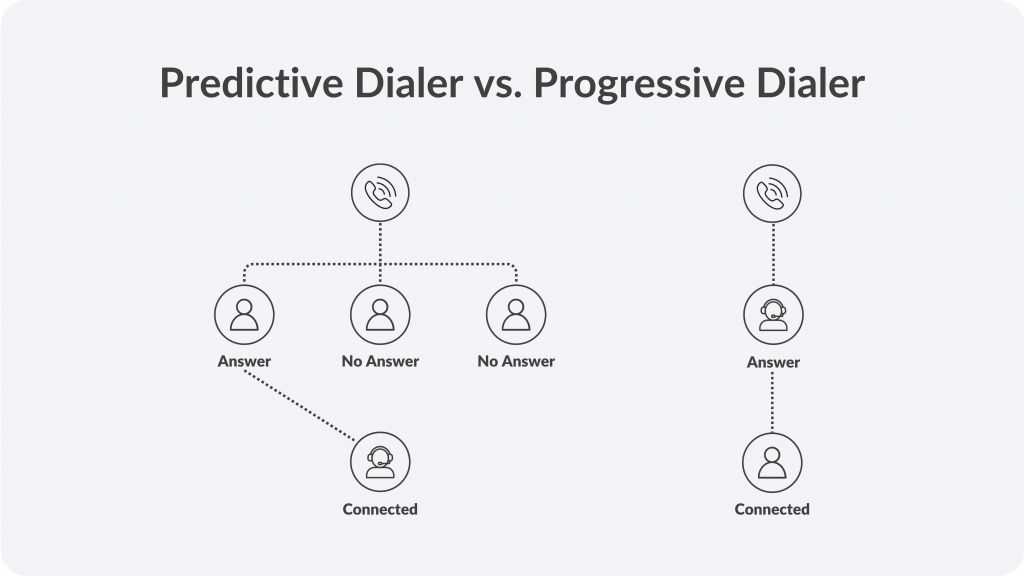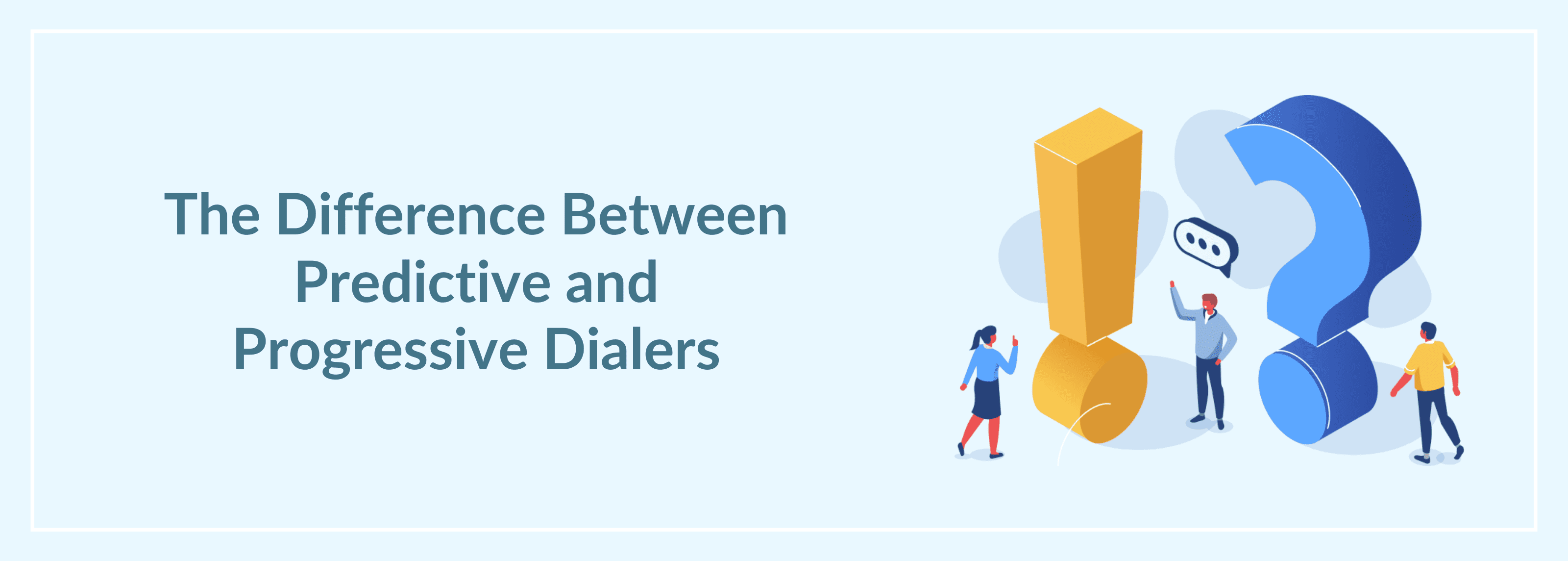Predictive Dialers vs. Progressive Dialers – Which One Is Right for You?
The purpose of every call center is to maximize the agents’ talk time and thereby increase the productivity of the agents and the call center.
So, almost all call centers have moved from the traditional manual dialing mode to auto dialing mode, which increases the productivity of agents and the call center output.
Predictive dialer and progressive dialer – both fall under the auto-dialing category. However, there are distinct differences that make them a preferred choice for certain use cases over others.
In this article, we will look at the differences between predictive and progressive dialing.
Before we understand the differences, let us spend some time defining them.
What Is Predictive Dialers?
A predictive dialer solution calls multiple numbers at once. As soon as the customer answers the calls, they are connected to an agent.
Predictive dialers take into account the number of agents available, the ratio of the number of dialed calls to the answered ones, and the average amount of time the agents take to wrap up the call. The predictive dialing algorithm makes use of this information and dials out automatically, maximizing the agent’s talk time and productivity.
The flip side of this is sometimes the customers answer the call even before an agent is available to take the call. This frustrates the customers, and most of them hang up, resulting in call abandonment.
While predictive dialing ensures that agent talk time is maximized, it comes across as an impersonal way to call a customer.
So, you have to be mindful of the flaws associated with predictive dialing before deploying it in your call center.
What Is Progressive Dialers?
Progressive dialers automatically dial a number from the list as soon as an agent is available and is ready to take the call.
Progressive dialers make calls one after the other and not multiple calls at the same time.
With progressive dialing, customers never get frustrated as an agent is always available to answer the call.
This is better for facilitating a more personal and productive interaction between your agents and customers.

Differences Between Predictive and Progressive Dialers
| Predictive dialer | Progressive dialer | |
| Dialing mode | It uses algorithms to predict when the agent will be available to take calls and dial out multiple numbers. It is ideal for maximizing agents’ talk time. | It is an automated dialer that dials one number at a time, and that too when an agent is available to take calls. It is ideal for personalized interactions. |
| Call frequency | It makes multiple outgoing calls for each available agent. The amount of downtime for agents is minimal or near zero. The call volumes are high. | One call at a time. The customer doesn’t have to wait for an agent to be available to answer the call. The call volumes are low as it is sequential dialing. |
| Call drop-rate | It makes calls even before the agent is available to take calls. This results in customers answering the calls without an agent being available, and it results in calls dropping. | The call drop rate is near zero, as progressive dialers dial out one call at a time and only when an agent is available to take the call. |
| Algorithms | It takes into account the number of agents, the average time it takes for the agents to dispose of a call and the ratio of dialed calls to answered calls. With this information, the algorithm dials out multiple numbers automatically, expecting the agents to be available when the call gets connected. The call answerability ratio goes up considerably. | It dials out numbers one at a time in a sequential manner. It does this only when agents are available to take calls, making it reliable. |
| Personal conversations | Agents don’t get the time to look over customer information, making it difficult for them to have personalized conversations and build relationships. | Agents can review the customer’s information before they go on a call. This makes it more personalized and results in deeper conversations. |
| Number of agents | You can reach more customers with less number of agents using predictive dialing. For instance, if you have to dial 15 numbers to have one connected call, the predictive dialer will make 300 calls to ensure that the needs of twenty agents are met. | While it is more reliable and personalized, you need more agents to handle customers in a progressive dialing environment. It makes only one call at a time and only when an agent is available. It makes 15 calls, one after the other, before someone answers the call, and this increases the agent’s idle time. |
| Regulatory compliance | Has to adhere to strict compliance regulations | Easier regulations to comply with. |
| Technology needs | Requires sophisticated algorithms and systems | The technology requirements are fairly less complex. |
What Is Ideal – Predictive or Progressive Dialing?
While both have their advantages and disadvantages, you have to consider the use cases for which you want to use them.
Based on your use case, you can choose one over the other.
What Are the Use Cases for Predictive Dialers?
Use Case 1
Let me give you an example.
Recently, we signed up a collections call center as our customer. They had the challenge of increasing their agent’s talk time from 2.5 hours to more than 3 hours.
We looked at their operations and understood they had 30 agents and only 90 channels to call. For every agent, they were making three calls.
We implemented our platform along with predictive dialing capabilities. We understood that they had to make 15 calls to have one connected call. We used 450 channels to keep their 30 agents busy using predictive dialing.
We improved their talk time from 2.5 hours to even 6 hours in some cases. On average, we increased it to 4.5 hours using predictive dialing.
For this use case of collections, predictive dialing might be the choice.
Use Case 2
Let us assume you are launching your broadband connection in a new market. You have bought a huge list to reach, and you have lined up 50 agents to start your outreach program.
The success of your outreach program is completely dependent on the number of people you get to talk to – predictive dialing should be your ideal choice.
It can maximize the number of contacts you make, and there is no need for you to keep the conversation personal with your prospects.
Whenever you need to reach more people, and you are selling a commodity, predictive dialing should be your preferred choice.
What Are the Use Cases for Progressive Dialer?
Use Case 1
Let me start with the example of the collections environment.
You are provided with a bunch of high-value loan account defaulters whose DPD (Due Past Day) is greater than 90 days.
You need to reach out to them, understand their issues, and restructure their loans in a way they find them easy to pay.
What do you use here?
You would obviously choose progressive over predictive dialing here. You may have to personally research these customers, their changed financial situation, and the reasons why they are not able to honor their EMI commitments and restructure their loans.
Progressive dialing will be the way to go here.
Use Case 2
Your customer is doing a high-profile webinar with three industry veterans, and you are tasked with inviting registrants from a particular target segment to the webinar.
You have a predefined list, and you need to have conversations with them and get them registered.
What do you prefer?
Progressive dialing will be the ideal choice for this use case.
You will have personalized conversations with your prospects, advising them on why they should be attending the webinar and what their takeaways would be.
Both progressive and predictive dialers help organizations manage and automate their outbound programs effectively.
The biggest tradeoff between predictive and progressive dialers is the number of calls made versus the quality of agent-customer interactions.
Predictive dialers help agents to interact with more customers and leads in a short amount of time. If your goal is to reach as many customers as possible, and you are not worried about call abandonment, you should opt for predictive dialing.
Progressive dialers help agents improve customer engagement, personalize interactions, and convert more high-value leads. If your objective is quality over quantity, then you should look at progressive dialing.
As a contact center, you need to weigh both the quality and quantity of calls, as well as the nature of the outbound campaigns, before choosing to go with either progressive or predictive dialers.
